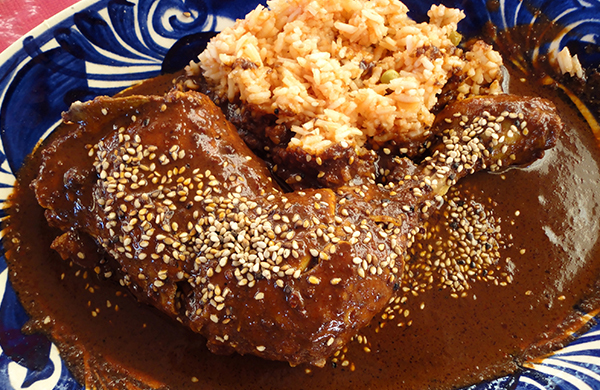
It's one of the most iconic Mexican dishes that exists. It's also one of the oldest, with the hows, whens, and whys of its creation muddled by time and legend. For our neighbors to the south, it's a staple Cinco de Mayo food, but it's also ubiquitous at almost any large celebration or social gathering. And though its composition is simple, making it requires a lot of time and ingredients (which can, depending on variety, vary wildly). We're speaking, of course, about mole sauce: the most complicated "simple" food on the planet.
So what is mole (pronounced mow-LAY), exactly? When it comes to the recipe, you can bank on chilies, spices, and maybe some nuts or chocolate being involved, but that's about it. That being said, it's not uncommon for 30 or 40 different ingredients to be used in the sauce, which is sopped up with soft tortillas or ladled over chicken or turkey. And many Mexican regions have their own take on mole, resulting in a completely different dish depending on where it's made. Read on to get a better look at a few mole recipes from regions in Mexico (all of which claim to be the home of the original).
Mole Poblano
Puebla

Mole poblano is the most popular version of the dish in the region of Puebla, and if you're heading out to a Cinco de Mayo festival, this is the one you're likely to be served. As far as moles go, this one's actually relatively simple: roasted poblano peppers join bits of Mexican chocolate and ingredients like peanuts and plantains to give the sauce a deep, earthy taste that's not too sweet or spicy.
Mole Negro
Oaxaca

Oaxaca is famous for the many varieties of mole found within the region. Seven are commonly mentioned as the most popular—although there are likely many more found there—and mole negro is one of them. As its name suggests, mole negro is a dark-brown or black version of the sauce. This mole recipe is also renowned for its lengthy list of ingredients: ancho, pasilla, mulato, guajillo, and sometimes chipotle make up just the chile portion. The charring of those peppers, along with a dose of chocolate, helps give mole negro its distinct color. Tomatoes, tomatillos, raisins, avocado leaves, and bread (used as a thickening agent) are also usually added alongside an array of spices to complete the dish.
Mole Prieto
Tlaxcala

At first glance, mole prieto looks an awful lot like mole poblano. But there are a couple steps in the preparation of this mole sauce that make it different. Fittingly, these steps vary depend on where the mole is being made. In the town of Santa Ana Chiautempan, for example, mole prieto is made in gigantic cauldrons over the course of several days by a host of cooks. The mass quantities of the sauce are then used to feed hordes of revelers during holidays. Cooks in Tetla, Tlaxcala, meanwhile, use something called huitlacoche—a mushroom-like corn fungus that's considered a delicacy—to give their mole prieto a unique twist.
